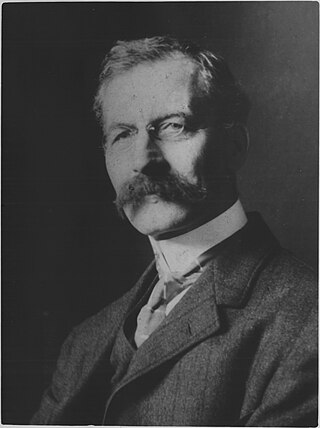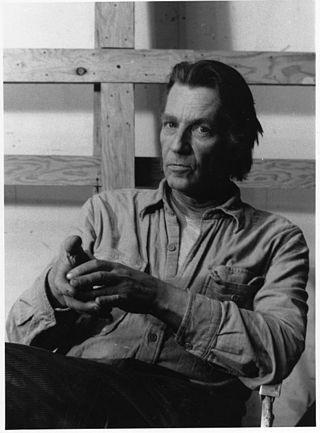
Jean-Paul Riopelle, was a Canadian painter and sculptor from Quebec. He had one of the longest and most important international careers of the sixteen signatories of the Refus Global, the 1948 manifesto that announced the Quebecois artistic community's refusal of clericalism and provincialism. He is best known for his abstract painting style, in particular his "mosaic" works of the 1950s when he famously abandoned the paintbrush, using only a palette knife to apply paint to canvas, giving his works a distinctive sculptural quality. He became the first Canadian painter since James Wilson Morrice to attain widespread international recognition and high praise, both during his career and after his death. He was a leading artist of French Lyrical Abstraction.

Marc-Aurèle Fortin was a Québécois painter, known best for paintings that convey the charm of small-town Quebec.

William Brymner, was a Canadian figure and landscape painter and educator. In addition to playing a key role in the development of Impressionism in Canada, Brymner taught numerous artists who became leading figures in Canadian modern art.
Fernand Toupin was a Québécois abstract painter best known as a first-generation member of the avant-garde movement known as Les Plasticiens. Like other members of the group, his shaped paintings drew upon the tradition of geometric abstraction, and he cited Mondrian as a forerunner. In 1959, Toupin began working with a more lyrical, though abstract, way of painting. The last decade of his career saw his return to geometric abstraction. Like Jean-Paul Mousseau, Toupin created works which lay outside the standard boundaries of art such as his stage sets for ballets.

Clarence Alphonse Gagnon, LL. D. was a French Canadian painter, draughtsman, engraver and illustrator. He is known for his landscape paintings of the Laurentians and the Charlevoix region of eastern Quebec.
Albert Dumouchel was a Canadian printmaker, painter and teacher. Dumouchel also was a photographer and musician. His work as an artist ranged from abstract to figurative.
Louis Jaque was a Canadian painter who belonged to the Quebec modernist movement of the post war period. He is known for pure abstract painting, printmaking, furniture design, interior decorator, and teaching.
Valentin Gallery is an art gallery in Quebec. Created in 1934, it was first called "L'Art français" and had its start on Laurier Street in Montreal. Owners Lucienne (1900-1992) and Louis (1890-1956) Lange initially showed works by French artists. By the 1940s they were offering art by Marc-Aurèle Fortin and Philip Surrey. In 1975, Jean-Pierre Valentin purchased the gallery. The gallery moved to its present Sherbrooke Street location later and changed the name to Valentin Gallery.

Robert Wakeham Pilot DCL was a Canadian artist, who worked mainly in oil on canvas or on panel, and as an etcher and muralist. He is known for his ability to capture the tone and atmosphere, especially at twilight, of the landscape of Quebec. Pilot is the last of the Canadian painters considered "to lend authority to Canadian Impressionism". He also accepted commissions as a book illustrator.

John Young Johnstone was a Canadian Impressionist painter, known for his paintings of life in city, town or countryside, as well as for scenes of Montreal's Chinatown.

Joseph-Charles Franchère was a painter, illustrator and church decorator in Montreal, Quebec.
Jean Albert McEwen was a Canadian painter known for his lyrical abstraction.
Léon Bellefleur D.F.A. was a French-Canadian abstract painter and print-maker.

Edmund Alleyn had an art career that underwent many stylistic changes. He explored various styles of painting including abstraction, narrative figuration, technology and pop art, as well as different media. Critics feel that his inability to be categorized marks him as contemporary. Even more important, they say that he helped remove excessive compartmentalization from art practice.
Stanley Cosgrove was a Canadian painter, draughtsperson and muralist. His landscapes are praised for their serenity.

Louis Belzile was one of the main figures in geometric abstraction in painting in Quebec and one of the members of the Plasticiens group in Montreal along with Rodolphe de Repentigny (Jauran), Jean-Paul Jérôme and Fernand Toupin.

Adrien Hébert was a painter who has been called the first interpreter of Quebec modernity. He was inspired by the port of Montreal and the city itself.
Richard Lacroix is a Canadian engraver, painter and sculptor who increased recognition for Canadian printmaking. He was the founder of Atelier Libre (1964), the first printshop in Canada which made printmaking facilities available to contemporary artists, as well as the Guilde Graphique (1966).
Roland Poulin is a Canadian contemporary sculptor whose work is characterized by its horizontality and weightiness. He has lived in Sainte-Angèle-de-Monnoir, Quebec, since 1986.
Jean-Paul Jérôme was a painter, designer and sculptor, who was a co-founder of Les Plasticiens in 1955. He was a key figure in Quebec's abstract art scene of the second half of the 20th century.












